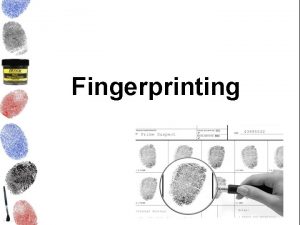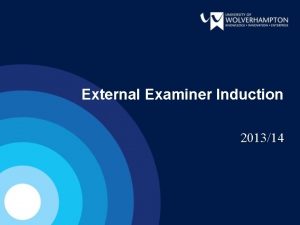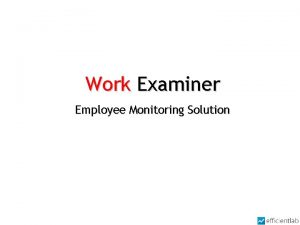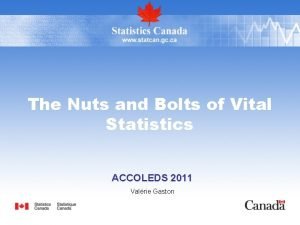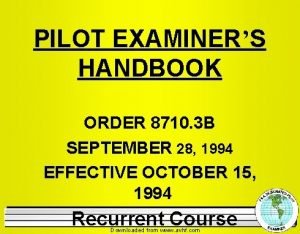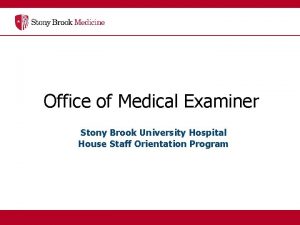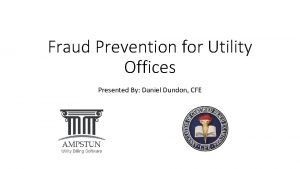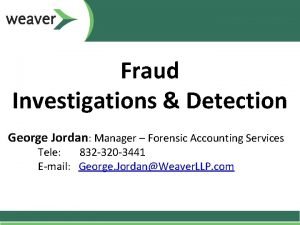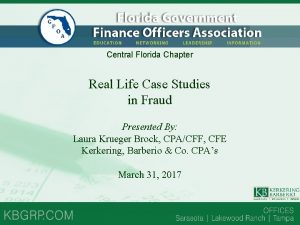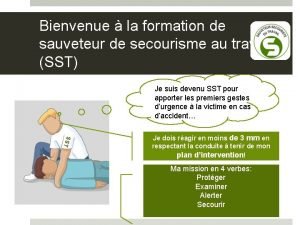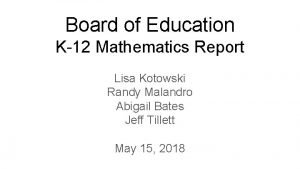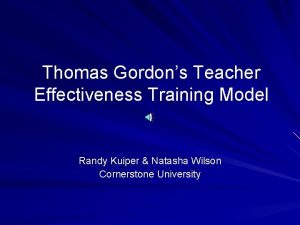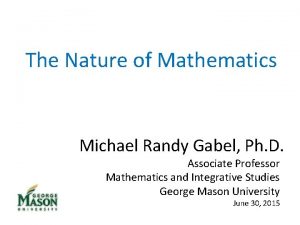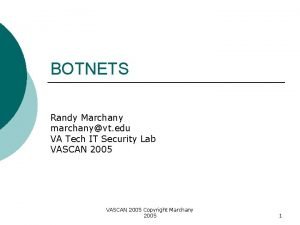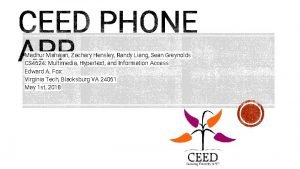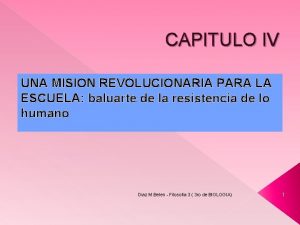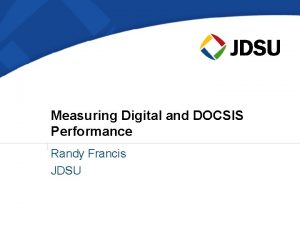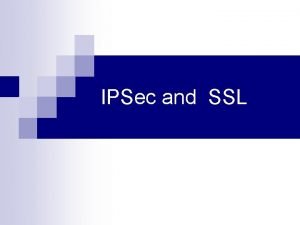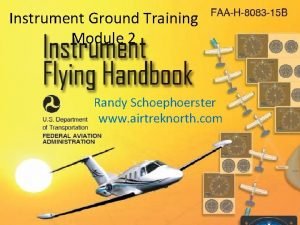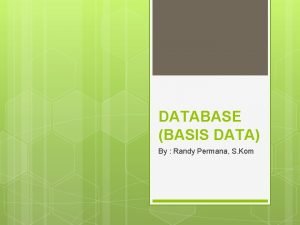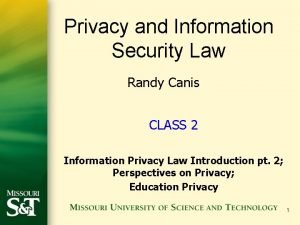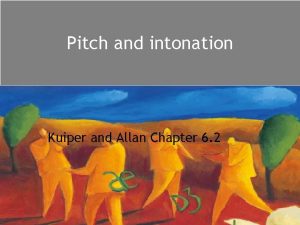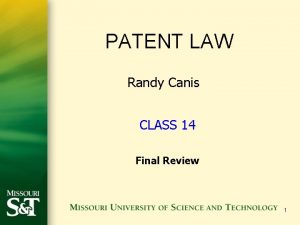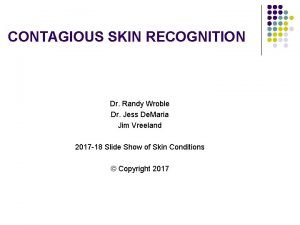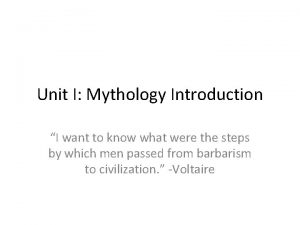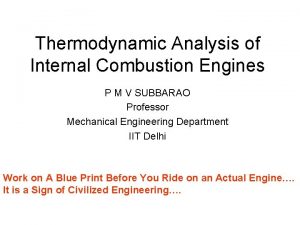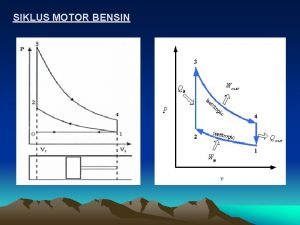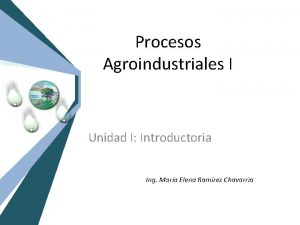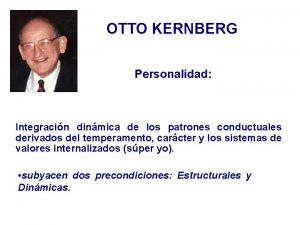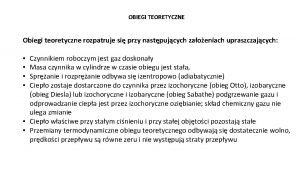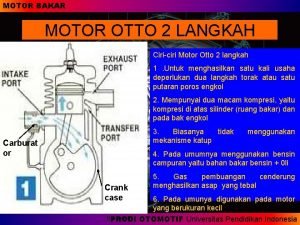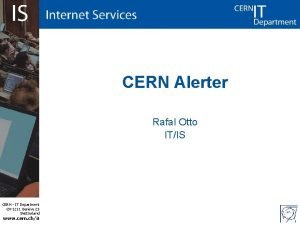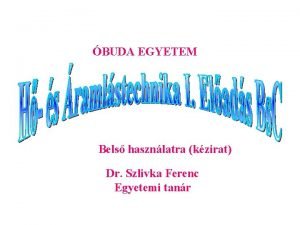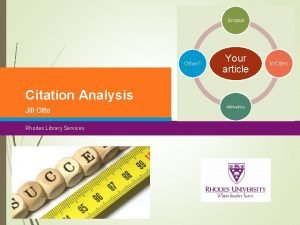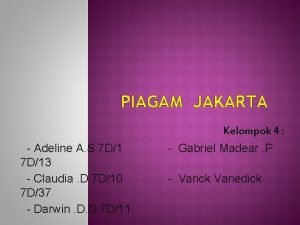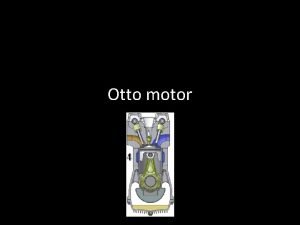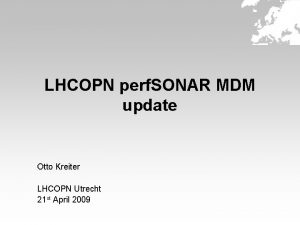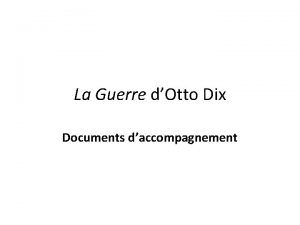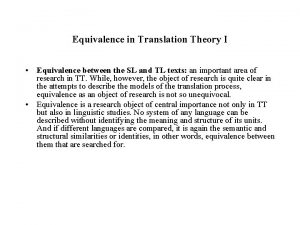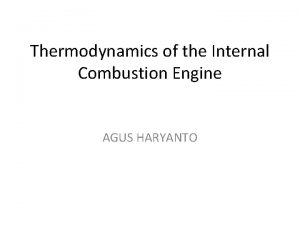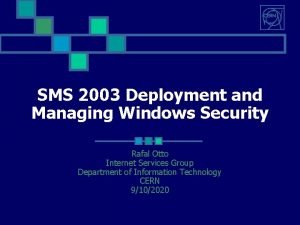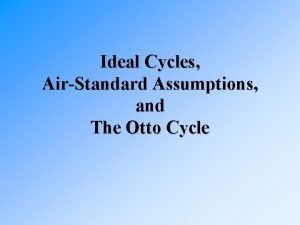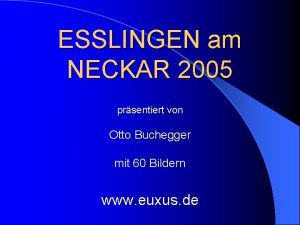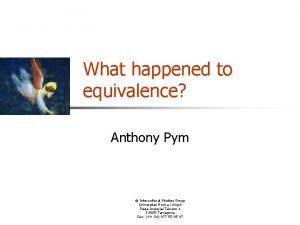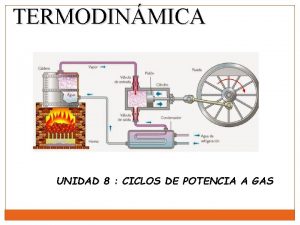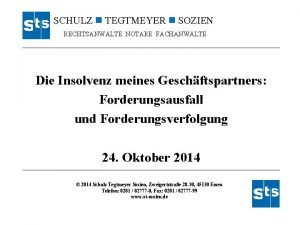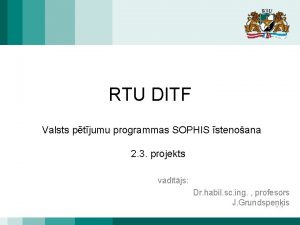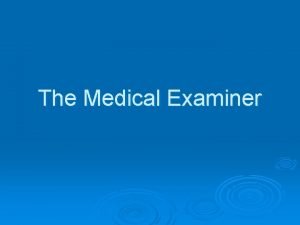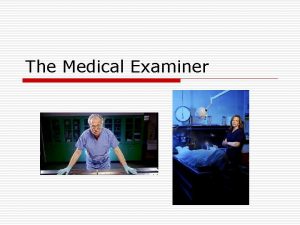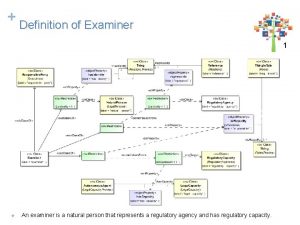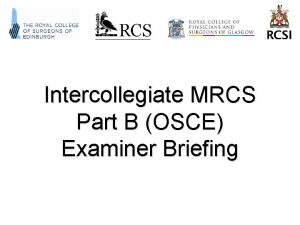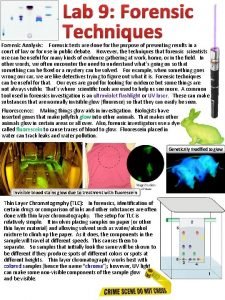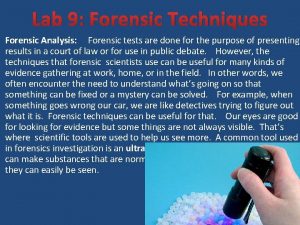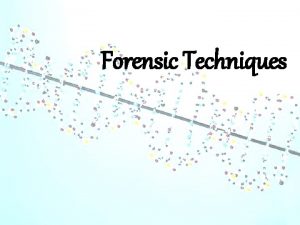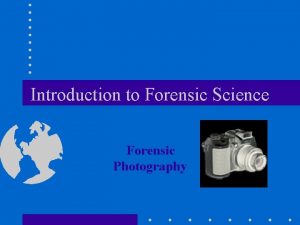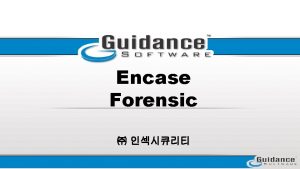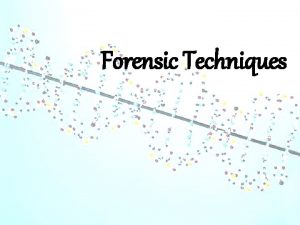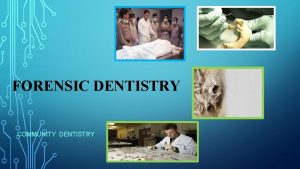Florida Forensic Examiner Training Randy K Otto Ph






















































































































































- Slides: 150

Florida Forensic Examiner Training Randy K. Otto, Ph. D, ABPP University of South Florida Christopher Slobogin, JD, LLM Vanderbilt University Tampa, Florida August 2016

The Law Governing Forensic Practice • Three types of law • Substantive law: identifies the scope of the forensic evaluation (e. g. , law defining competency) • Procedural law: regulates how evaluations are carried out (e. g. , privilege, confidentiality) • Evidence law: governs how, and what kind of, information is presented to the legal decision maker (e. g. , statutory rules defining expertise, constitutional rules regarding the right to remain silent) • These laws vary significantly between jurisdictions (federal v. state; state v. state)

The Definition of “Expert” • Experts can offer opinion testimony – Lay witnesses can offer opinions only to extent needed to understand their observations (F. S. 90. 701), e. g. , the statement “He was acting crazy” might be barred • When is a witness an expert? The three E’s: – Education: • Courts usually accept psychiatrists and licensed doctoral level psychologists (Ph. Ds, Psy. Ds, Ed. Ds) • Social workers? Others? Depends on the court and issue involved • Legal education – Experience: See Jenkins v. United States, 307 F. 2 d 637 (D. C. Cir. 1962) – Evaluation procedure: That’s what this course is about

When Should Qualified Experts Testify? • Only when they have “scientific, technical, or specialized knowledge which will assist the trier of fact. ” F. S. 90. 702. – Morse: experts should only describe observations? – Ultimate issue testimony (e. g. , “Defendant is insane”) • Florida: permitted if based on specialized knowledge • Federal court: barred under FRE 704(b) • And only when the basis of testimony is “reliable” (F. S. 90. 702) i. e. , – “(1) the testimony is based on sufficient facts or data; (2) the testimony is the product of reliable methods and principles, and (3) the expert witness has applied those principles and methods reliably to the facts in the case. ” – Reliability (i. e. , validity) can be assessed by considering whether techniques have: (1) been subject to testing, (2) known error rates, (3) adhered to adequate standards (4) been subject to peer review, and/or (5) are generally accepted in the relevant field. Daubert v. Dow Pharmaceutical (1993) – Compare Frye v. United States (1923) (the pre-2013 test in Florida). – Is a diagnosis of schizophrenia reliable? BWS testimony? VRAG testimony? An assessment of credibility?

Information That May Form the Basis of Expert Testimony • Information must be of the type “reasonably relied upon” by experts in the field (F. S. 90. 704) – Hearsay? (e. g. , out-of-court declarations by relatives, police, other experts; mental health records) – Suppressed evidence? – Hypnotically-induced statements? Stokes v. State, 548 So. 2 d 188 (Fla. 1989) (inadmissible under Frye). • Crawford v. Washington, 541 U. S. 36 (2004) (defendants have the right to confront accusers) – Statements made to investigators may be inadmissible unless witness is in courtroom, dead, or asserting the 5 th amendment – People v. Goldstein, 843 N. E. 2 d 727 (N. Y. 2005) (Crawford applies to witnesses relied upon by forensic examiners) • Also see F. S. 90. 704: “Facts or data that are otherwise inadmissible may not be disclosed to the jury. . . unless the court determines that their probative value in assisting the jury to evaluate the expert’s opinion substantially outweighs their prejudicial effect”

Summary of the Expert’s Obligations • Make sure you’re qualified (education, experience and evaluation procedure) • Make sure your testimony is based on specialized knowledge that adds to what a layperson could deduce (or at least makes the issues more clear) • Make sure your testimony is based on reliable (i. e. , valid) theories/principles (either scientific research or at least widely accepted diagnosis/clinical wisdom) • Make sure your testimony is based on reliable (i. e. , valid) facts, or at least that you can explain why you think they are reliable (especially if the fact is hearsay, or otherwise inadmissible)

Stages of the Criminal Process and Constitutional Doctrines Relevant to Forensic Practice

Why Knowledge of the Criminal Process is Useful • The examiner works in the criminal system • Evaluators should know what types of useful information each stage produces • Different stages trigger different constitutional rules (e. g. , 6 th Amendment only applies postcharge) • Knowledge of the system is necessary to evaluate the defendant’s knowledge of the system (in competency examinations)

Pre-Adjudication Stages • Arrest & booking (police report; jail interview) • First appearance (“arraignment”) – Rights notification, appointment of counsel – In minor cases, trial; in other cases, probable cause & bail decisions • Various Motions: – – To suppress (4 th & 5 th amendments) For discovery (FRCP 3. 220): depositions/interrogatories For ex parte evaluation—made by defense; results go to defense For court-retained evaluation—results go to all parties • For competency, motion can be made by any party prior to or during trial • For sanity, motion can be made by any party, after notice of an intent to raise the insanity defense (FRCP 3. 216(c)(d)). • Plea of insanity must be made within 15 days of arraignment or the filing of a plea of not guilty. FRCP 3. 216(c)

Adjudication Stages • Plea hearing – – 90%-98% of all criminal cases are resolved through a plea Usually a plea is the result of plea bargaining The judge determines if plea is “voluntary & knowing” Insanity acquittals may result from pleas • Trial – Voir dire (selection of jury) – Defendant has right to jury trial, if the potential sentence ≥ 6 months – The state has burden of proof regarding the offense, whereas the defense has the burden of proof regarding insanity

Post-Adjudication Stages • In non-capital cases, if convicted: – Judge sentences, using sentencing guidelines (see App B) – Sentence is appealable if judge departs from the guidelines • In capital cases, if convicted: – The jury sentences based on aggravating and mitigating circumstances – People with intellectual disability and juveniles are exempt from the death penalty (see Atkins v. Va. , 536 U. S. 304 (2002) & Roper v. Simmons, 543 U. S. 551 (2005)). • If the verdict is not guilty by reason of insanity: – Result is usually hospitalization (see later in this outline) – Length of disposition is usually equal to or greater than the criminal sentence would have been

Ex Parte Evals. & the Constitution • Ake v. Oklahoma, 470 U. S. 68 (1985) – Under due process clause, if the defendant demonstrates that sanity or dangerousness will be a “significant factor” at trial: • The state must provide a competent expert “to assist in evaluation, preparation & presentation” of case • The defendant is entitled to only one expert and not necessarily the expert of his or her choice – Not clear whether the defendant is also entitled to expert on other mental state issues • Florida law, FRCP 3. 216(a) – Provides defense with one state-funded expert for competency and sanity evaluations – Results of the evaluation are sent only to the defense

Court-Retained Evals & the Constitution • Estelle v. Smith, 451 U. S. 454 (1981) – Holding 1: under the 5 th Amendment, the defendant has the right to remain silent unless the results are used only to inform competency decisions – Holding 2: under the 6 th Amendment, the defendant has the right to have counsel notified of the evaluation • Florida law – Information obtained during a competency evaluation may be used only to assess competency unless the defendant uses it for some other purpose. FRCP 3. 211(d). – The same rule probably applies to information obtained during a sanity evaluation. FRCP 3. 216(b). See Lovette v. State, 636 So. 2 d 1304 (Fla. 1994). – The defense attorney must be notified of all court-retained evaluations and has the right to be present during the evaluation. FRCP 3. 210(b); 3. 216 (d)

Implications for Evaluators Conducting Court-Retained Evaluations • For competency and post-notice sanity evaluations examiners – Should not tell defendants they have a right to remain silent – Can tell defendants their statements should not be used at trial unless they raise an insanity defense • For pre-notice sanity evaluations – Examiners should probably make sure the defense attorney knows the evaluation is occurring – Theoretically, results should not go to the court or prosecutor unless and until notice is given (see Manuel v. Fla. , 5 th D. C. A. , 2015) – If a court-retained evaluation takes place before counsel is appointed or without notice, the results are inadmissible • If the presence of an attorney is not an attractive option, the evaluator should suggest: – Taping as a alternative – The attorney’s evaluator as a substitute

Understanding the Forensic Evaluation Process

Distinguishing Forensic Assessment & Therapeutic Activities Therapeutic Forensic Client/patient Attorney or court Focus of the evaluation Broad Narrow and defined by the law Confidentiality Therapist-patient None Privilege Psychotherapist-patient Attorney-client (at times) Professional’s stance Aligned, advocate Neutral, detached Sources of information Client/patient, perhaps some others Varied sources Utility of traditional medical/psych testing Significant Limited Assumed response style Candid Variable, hybrid Role of diagnosis Integral Limited Goal of interaction Betterment of patient Inform referral source

Distinguishing Forensic Assessment & Therapeutic Activities • Forensic activity, not a therapeutic activity – Examinee is not the client, but duties are owed to him/her nonetheless • The referral source is the client (but this does not mean you do not owe duties to the examinee) • Different sources of authority for practice and standards of care, e. g. , – Specialty Guidelines for Forensic Psychology – Ethical Principles for the Practice of Forensic Psychiatry

Distinguishing Forensic Assessment & Therapeutic Activities • Examinee’s privacy and dignity are always considered but, there is no conventional confidentiality or psychotherapist-patient privilege • Attorney-client privilege applies in those cases in which you are retained by the defense

Distinguishing Forensic Assessment & Therapeutic Activities • Informed consent is often unnecessary, although assent/notification is required • Considerably more reliance on collateral information, e. g. , – – – Defense attorney accounts Arrest reports Healthcare records Witness statements Sentencing score sheets • Consideration of response style is critical

Distinguishing Forensic Assessment & Therapeutic Activities • Evaluation is narrow and legally focused • Much traditional/common psychological and medical testing is of limited value • Diagnosis if of limited importance, but not irrelevant, e. g. , – Competence restoration – NGI defense availability

Mental Disorders and the Law According to APA • “In most situations the clinical diagnosis of a DSM-5 disorder is not sufficient to establish the existence for a legal purpose of a ‘mental disorder, ’ ‘mental disability, ’ ‘mental disease, ’ or ‘mental defect’. ” (DSM-5)

Mental Disorders and the Law According to APA • “…the use of DSM-5 should be informed by an awareness of the risks and limitations of its use in forensic settings. When DSM-5 categories, criteria, and textual descriptions are employed forensic purposes, there is a risk that diagnostic information will be misused or misunderstood. These dangers arise because of the imperfect fit between the questions of ultimate concern to the law and the information contained in a clinical diagnosis. In most situations, the clinical diagnosis of a DSM-5 mental disorder…. does not imply the individual with such a condition meets legal criteria for the presence of a mental disorder or a specified legal standard…(DSM-5, p. 14).

Primary Components of a Proper Forensic Evaluation & Report • Adequate and correct notification • Understanding of and focus on the proper legal matters and criteria (and nothing else) • Access to relevant third party information • Explicit consideration of response style

Primary Components of a Proper Forensic Evaluation & Report • Meeting of duties to all parties • Provision of factual basis for all meaningful opinions • Use of language and discussion of complicated matters in ways the audience can understand – Competence: judge – Sanity: judge or jury

Sources of Authority in Forensic Evaluation • Law regulating practice of the profession (e. g. , FS 455, FS 490, FS 491) • Laws defining the legal matter at issue (e. g. , FS 916) • Professional ethics • Practice guidelines specific to forensic pursuits – Specialty Guidelines for Forensic Pschology (APA, 2012) – Ethical Guidelines for the Practice of Forensic Psychiatry (AAPL, 2005)

Exercise • You were appointed by the court to evaluate the defendant’s mental state at the time of the offense (sanity). Your findings and opinions provide support for an insanity defense. A few days before the trial is to begin, the prosecutor calls you to discuss your evaluation. How do you deal with her inquiries about…. – Your general forensic experience, such as how many evaluations you have completed, and how many times you’ve testified for the defense? – The limitations of your findings? – Inconsistent and non-supportive data?

Exercise • Your defense-retained evaluation of the defendant’s mental state at the time of the offense provides evidence that supports an insanity defense. While meeting with the defense attorney before trial, she shows you the report of a state-retained examiner that contains some dubious assertions – e. g. , that the validity scales of the MMPI indicate that the defendant was not being truthful in his description of the offense rendered the previous February. – How do you handle inquires by the defense attorney regarding what the state retained expert’s report says? What if she asks you to provide her questions that she can ask the state-retained expert? – How will you respond to these questions if the defense attorney asks them of you while you are on the witness stand? – How do you deal with questions from the defense attorney aimed

Exercise • You are conducting a sanity evaluation via court appointment. The arrest report and the defendant’s report make clear he was hallucinating and was delusional thoughts about the victim at the time of the offense. There is a differential diagnosis question of schizophrenia v. drug induced psychosis. The defendant reports he had taken some medications his mother had in her bedstand on the evening of the offense. – Do you the mother in an effort to ascertain the kind of drug? – Assume the mother demands that you guarantee her absolute confidentiality before she will answer any questions about the medications in her nightstand from him – What are the issues here and what should you do?

Exercise • A defendant is ordered by the court to undergo evaluation of his competence to proceed. You conduct an evaluation and opine that the defendant is incompetent and meets criteria for involuntary hospitalization on the grounds he is dangerous to others. • The defendant goes off to and comes back from the forensic hospital and pleads guilty, and the case is set for sentencing. The state attorney calls to ask you to testify at the sentencing hearing. Acknowledging that you likely have no opinion about the defendant’s current risk, she advises that the data you gathered regarding his aggressive behavior in the past will be solicited to guide the court’s sentencing decision. • What can you do, what will you do?

Competence to Proceed

Rationale and Standard for Competence to Proceed Requirement • Rationale. Drope v. Missouri, 420 U. S. 162 (1975) – – Sixth Amendment right to confront accusers Due Process right to a fair proceeding Societal duty to preserve the dignity of the criminal process These concerns are also applicable to other criminal proceedings (e. g. , sentencing, probation revocation) • Competence Standard (Dusky v. U. S. , 362 U. S. 462 (1960); F. S. 916. 12(3); FRCP 3. 211(a)(1)) – The defendant must have “sufficient present ability to consult with his lawyer with a reasonable degree of rational understanding and. . . a rational as well as factual understanding of the proceedings…” – Key aspects of test: • Two capacity prongs (consult with attorney; understanding of proceedings) • Present-oriented and cognitively focused • Capacity level need not be significant, merely reasonable

Florida’s Six Factors F. S. 916. 12(3) and FRCP 3. 211(2) • Capacity to: – 1. Appreciate charges or allegations (cf. Grover; Henderson) – 2. Appreciate the possible penalties (cf. Jesus Christ 2000) – 3. Understand the adversary nature of the legal process • Roles of participants; nature of process; rights to remain silent, confront witnesses, jury, pleas and significance – 4. Disclose to attorney facts pertinent to the proceedings • What if def has amnesia for offense or gives “crazy” account of offense? • Self-incrimination concerns (keep report general in some ways) – 5. Manifest appropriate courtroom behavior (cf. Allen) – 6. Testify relevantly (often an irrelevant factor) • Report must include – Analysis of these six factors and – “Any other factors deemed relevant” (e. g. , capacity to relate to attorney, challenge witnesses, be motivated, appraise strength of state’s case, make a rational plea decision/assessment)

Observations About the Competency Standard • The test is a ______ one; it is not based on diagnosis or treatability. • The statute requires a _______ as a predicate for an incompetency finding. F. S. 916. 12(2) • The test focuses on ______, as distinguished from actual knowledge or willingness; however, the evaluator should be familiar with the facts of the case (see factors 1 , 2, 4 & 6) and the legal process (3, 4, 5) • The degree of impairment must be _______; only 10% to 30% examinees are adjudicated incompetent • The final conclusion on competency is often based on ______ factors such as the nature of the charge; the competency issue is ultimately a _____ one.

Competency to Plead Guilty and Waive Counsel • Pleading Guilty (Boykin v. Ala. , 395 U. S. 238 (1969))— Defendant must be OK on factors 1 -4 plus: – Actually understand that a guilty plea waives rights to silence, confrontation, jury and trial counsel – Be able to plead “voluntarily” (i. e. , not feel coerced into pleading guilty) • Waiving Counsel (Godinez v. Moran, 509 U. S. 389 (1993) —Defendant must be competent to proceed plus: – If pleading guilty: Must be competent to plead guilty – If going to trial: Must be able to carry out “basic trial tasks”. Indiana v. Edwards, 554 U. S. 208 (2008).

Restoration of Competency • If the defendant might be incompetent or if continued competency requires treatment, FRCP 3. 212 requires that the evaluator address: – Whether the def is restorable within a reasonable period of time; – Whether restoration can be outpatient (which may only last one year) – Whether, if inpatient treatment is required, defendant meets the commitment criteria (see pp. ) • If the defendant is found incompetent – Defendant may only be subject to treatment for a “reasonable period” necessary to determine whether he is restorable. If not, the state must release or civilly commit. Jackson v. Indiana, 406 U. S. 715 (1972) – F. S. 916. 303(2)(b) provides that charges must be dismissed after: • 5 years, for felony charges against people with mental illness • 1 year, for misdemeanor charges against people with mental illness • 2 years, for people with intellectual disability – However, dismissal is “without prejudice”

Procedures of Competency Evaluations • Ex parte evaluation: Results go only to defense FRCP 3. 216(a) • Court-retained evaluation FRCP 3. 210(b) – Any party may request it – Motion must be in writing and contain a recital of specific observations that triggered the motion – The court must appoint 2 or more experts (one from the Agency for Persons with Disabilities if intellectual disability is suspected) – The court order must identify the purpose of the evaluation, the areas of inquiry, the legal criteria, and the report deadline – If defendant is not in custody, the court can order the defendant to appear at a specific time and place – The report must identify 1) the evaluation procedures used, 2) the clinical observations made, 3) the sources of information relied on, and 4) the factual basis for the findings – Both attorneys may be present during the evaluation. FRCP 3. 211(3)

Summary of Examiner’s Duties • Report must address – Competency (the six factors, plus any other relevant factors, plus Dusky) – Restorability (treatment alternatives, availability of alternatives, likelihood of attaining competency, assessment of probable duration). See F. S. 916. 12(4). – Commitment criteria (if examiner believes it likely the defendant will be found incompetent and hospitalization is needed) • Examiner must also be available for testimony – Usually parties stipulate on competency issue – Hearings are supposed to occur w/in 20 days of motion for court-retained evaluation and may also occur after return from the hospital. See FRCP 3. 212. – Post-commitment periodic review by hospital must occur after first 6 months and every year thereafter

Involuntary Medication • Sell v. United States, 539 U. S. 166 (2003). Permissible if: – Defendant is charged with serious crime, OR – Defendant is dangerous to self or others w/in foreseeable future, OR – Defendant is incompetent to make treatment decisions, AND – Medication is 1) effective; 2) necessary; 3) not harmful to trial rights; 4) medically appropriate • Florida Law – F. S. 916. 107(3): consistent with Sell, plus medication is permissible w/o judicial order in emergency situations – FRCP 3. 212(c)(2): local court may order forcible medication (to avoid revolving door) – F. S. 916. 12(2); FRCP 3. 215(c): medicated D. may be tried • Defendant who asserts insanity defense – May obtain instruction regarding the effects of medication – Cf. Vermont practice (allows waiver of competency right)

Exercise • Ted understands his charges (i. e. , using bombs to kill and maim technology experts) possible consequences (life imprisonment or execution), and the nature of criminal proceedings. He told his attorney that he planted the bombs to send a message about the harm technology does, and he will take every opportunity to disrupt his trial (e. g. , yell out in protest, stand up and face away from the judge and jury) and make clear how “corrupt” the system is. He is not even sure he trusts his attorney since he is part of the system. • What are your thoughts about his competence…how might the court deal with his intent to disrupt the trial?

Exercise • A 42 year-old male is charged with aggravated battery of a famous movie actress he was stalking. He tells the defense attorney and examiner that he will plead “not guilty” as he was acting in “self defense. ” The defendant understands the charges, possible penalties, his rights as a defendant and the nature of the proceedings. Regarding his defense strategy, he voices a delusion that the actress was controlling his behavior through microchips she implanted in his brain, and by administering painful electric shocks to him each time he behaved in a way she did not like. • What are your thoughts about his competence?

Assessment of Competence to Proceed in the Criminal Process

Key References • Frederick, De. Mier, & Towers (2004). Examination of competency to stand trial: Foundations in mental health case law. Sarasota, FL: Professional Resource Press. • Zapf & Roesch (2009). Best practices in forensic mental health assessment: Competence to stand trial. New York: Oxford University Press. • Kruh & Grisso (2008). Best practices in forensic mental health assessment: Juveniles’ competence to stand trial. New York: Oxford University Press.

Key References: Competence • Otto & De. Mier (2007). Assessment of competence to proceed in the criminal process. In H. Hall (Ed), Forensic psychology and neuropsychology for criminal and civil cases. Boca Raton, FL: CRC Press. • Grisso (2003). Evaluating competencies: Forensic assessments and instruments (2 nd edition). New York: Kluwer/Plenum. • Melton, Petrila, Poythress, Slobogin, Lyons, & Otto (2007). Psychological evaluations for the courts (3 rd edition). New York: Guilford.

Background • Research by Poythress and his colleagues (LHB) indicates that defense attorneys have questions about the competence of approximately 15% of their clients, yet they request evaluations in only half of those cases • Research by Viljoen and her colleagues suggests similar referral rates by attorneys representing kids in the juvenile justice system

Background • Data indicate anywhere from 20% to 30% of defendants who undergo evaluation are adjudicated incompetent • Research by Murrie and his colleagues (PPPL), however, indicates that there is considerable variability across practitioners (0% to about 60+ %) and disciplines/professions

Florida’s Competence to Proceed • Dusky, as operationalized or informed by the examiner’s consideration of the defendant’s: – Appreciation of charges and allegations – Appreciation of possible penalties – Understanding of the legal process and roles of those involved – Ability to work with attorney and provide information of relevance – Ability to understand participate in proceedings – Ability to testify – And, anything else the examiner believes might be relevant • Appreciation of strength of state’s case • Plea agreement understanding and decision making

Bonnie’s Conceptualization of Competence • Adjudicative Competence – Understanding of the legal system and the roles of those involved – Understanding of specific charges and allegations • Decisional Competence – Ability to weigh and manipulate information – Ability to work with one’s attorney and make rational decisions about one’s case

Assessing Competence to Proceed • Assessment of _______ competence (e. g. , knowledge of the legal process and the basis for one’s involvement) is than assessment of _____ competence and is what many examiners focus on as a result • Unassessed/undetected impairment in ______ competence may be responsible for most “false negatives”

Factual & Rational Understanding of the Proceedings • Understanding and appreciation of – The adversarial process – Relevant actors and their motivations – Rights as a defendant – Available pleas and their significance – Charges – Allegations – Likely and possible penalties

Factual & Rational Understanding of the Proceedings • Understanding of, appreciation of, and ability to participate in the process • Ability to identify and challenge evidence and witnesses • Ability to testify • Understanding and appreciation of state’s case • Understanding and appreciation of plea agreement process

Capacity to Consult With Counsel • Relationship with, beliefs about, and attitudes towards attorney • Ability to provide attorney with relevant information • Ability to assess likely outcomes in the context of legal decision making • Ability to deliberate and communicate with attorney regarding legal options and strategy

The Competence Evaluation Process

Assessment Techniques • Clinical Assessment Techniques (CATs) – Assess clinical constructs – Typically best researched and validated • Forensically Relevant Assessment Techniques (FRTs) – Assess clinical constructs of most relevance in forensic settings – Often the subject of less research (norms, properties) • Forensic Assessment Techniques (FATs) – Assess legal/psycholegal constructs – Often the subject of less research (norms, properties)

Assessment of Competence to Proceed • Assess competence related abilities • Assess cognitive/emotional/behavioral functioning in order to identify symptoms/impairments/disorders • Identify connection between cognitive, emotional, and behavioral impairments (if any) and limitations in competence related abilities (if any) • Identify treatments/interventions that may remedy significant disorders and deficits (if appropriate)

Pre-Evaluation Preparation • Contact “referral source” – Gather relevant information – Ascertain issues of (attorney-client) privilege • Access necessary records – Arrest report** – Indictment/information/charging** – Jail medical record – Medical and mental health records – Educational records – Arrest history

Competence Evaluation • Informed consent/assent/notification • “Relevant” history – Social/Family – Educational – Medical – Employment – Legal – Mental Health/Substance Abuse

Rationale for History Gathering in Competence Evaluations • Four reasons to gather historical information when performing competence evaluations – Potential relevance – Establish rapport and reduce anxiety – Vehicle to observe cognitive, emotional, intellectual, and behavioral functioning – Assist in assessment of response style

Some Thoughts About Gathering & Presenting History in Forensic Evaluation • How much of what we inquire about is or may be relevant to the psycholegal issues? • What should we do with information we gather that – is not relevant? – Is possibly relevant? – is clearly relevant?

Competence Evaluation: General Issues • Distinguish between adjudicative competence and decisional competence • Start with adjudicative competence then move to decisional competence • Regarding adjudicative competence, query for knowledge and, if present, survey for appreciation

Competence Evaluation: General Issues • Regarding adjudicative competence, if knowledge is not present, provide information and query/survey later for retention and appreciation • Consider starting the competence inquiry focused on systems issues and then move to case specifics (i. e. , start with Factor 3, then move on to 1, 2, 4, 5 and 6) • Consider using the arrest report as a tool in the evaluation

Competence Evaluation: General Issues • To address decisional competence, have a conversation with the examinee about the charges, possible penalties, his assessment of the state’s case and his goals • Keep in mind that knowledge does not always reflect capacity and lack of knowledge does not always indicate lack of capacity • Keep in mind distinctions between ability and willingness

Competence Evaluation: General Issues • Distinguish cynicism from paranoia—you may be able to get around these issues by asking how things should work, or how they might work for others • Distinguish uncommon political or religious beliefs from delusional thinking (perhaps this is easier said than done)…remember, a finding of incompetence requires a mental disorder of some type

Competence Evaluation: General Issues • Draw inferences about some capacities based on the examinee’s performance with you, such as capacity to – Work with counsel – Provide counsel with important information and challenge state claims – Testify – Understand participate in legal proceedings • But remember, interacting with you is probably not exactly like interacting with defense counsel or appearing in court

Competence Evaluation • Structured Competence Inquiry* – Understanding of the legal process and the roles of those involved, and one’s rights as a defendant – Understanding and appreciation of the charges, allegations, and possible penalties – Capacity to understand, appreciate, and challenge the state’s evidence – Understanding/appreciation of pleas and their significance – Capacity to relate to and work with attorney – Ability to testify and relay information of relevance to the attorney – Capacity to understand participate in proceedings

Competence Evaluation • Normed Competence Measures – Mac. Arthur Competence Assessment Tool-Criminal Adjudication (Mac. CAT-CA) – Evaluation of Competency to Stand Trial-Revised (ECST-R) • Structured Competence Assessment Tools – Fitness Interview Test-Revised (FIT-R) – Competence Assessment Instrument (CAI) – Juvenile Adjudicative Competence Interview (JACI)

Competence Evaluation • Assessment of Current Clinical Functioning – Specific inquiry regarding cognitive, emotional, and behavioral functioning and adjustment – Psychological testing* • CAIs • FRIs

Guidelines for Evaluation of Competence to Proceed • American Academy of Psychiatry and the Law (2007) • www. jaapl. org/cgi/content/full/35/Suppleme nt_4/S 3? ijkey=fc 1 edb 873 d 7 c 28 c 3453 ef 72 bfe 0 64249219 c 9 a 5 c&keytype 2=tf_ipsecsha

Competence Assessment Tools

Competence Assessment Instrument (Mc. Garry, 1973) • Appraisal of available legal defenses • Unmanageable behavior • Quality of relating to attorney • Planning of legal strategy • Appraisal of actors’ roles • Understanding of court procedure • Appreciation of charges • Appreciation of possible penalties • Appraisal of likely outcomes • Capacity to disclose offense information to attorney • Capacity to challenge witnesses • Capacity to testify • Self defeating versus self serving motivations

Fitness Interview Test-Revised

Fitness Interview Test-Revised • Structured, professional judgment tool • Anchored in English, Canadian, and American law • Focuses examination of three domains – Understanding of Proceedings – Understanding of Possible Consequences – Capacity to Communicate with Counsel

Understanding of the Nature of Proceedings • Arrest process • Current charges • Role of key participants • Legal process • Pleas • Court procedure

Understanding/Appreciation of Possible Consequences • Possible penalties • Available defenses • Likely outcomes

Capacity to Communicate with Counsel • Communicate relevant facts • Relate to lawyer • Plan legal strategy • Engage in a defense • Challenge witnesses • Testify relevantly • Manage courtroom behavior

Strengths of FIT-R • Anchored in American and Canadian competence law • Comprehensive evaluation • Research with adults and juveniles is promising • Face valid • Probably not an issue via Frye/Daubert

Limitations of FIT-R • Mis-named • Does not allow for normative comparisons • Not well-known

Evaluation of Competency to Stand Trial-Revised

ECST-R Nuts and Bolts • Structured and semi-structured interview which results in ratings of the examinee’s competence related abilities, which you can compare to normative data • 4 Competence Scales (semi-structured) – Consult with counsel (6 items) – Factual understanding of courtroom proceedings (6 items) – Rational understanding of courtroom proceedings (7 items)

ECST-R Nuts and Bolts • 5 Atypical Presentation Scales (structured) – Realistic – Psychotic – Non-Psychotic – Impairment – Both Psychotic and Non-Psychotic

ECST-R—Dusky Interface ECST-R Scale Dusky Factor Factual Understanding Consult with Counsel Capacity to Assist Counsel Rational Understanding Overall Rational Ability Rational Understanding

ECST-R Psycholegal Abilities • Consult with counsel (6 items) – Assesses perceptions and experiences with attorney • Factual understanding of courtroom (6 items) – Assesses basic knowledge of charges and the roles of those in the legal process • Rational understanding of courtroom (7 items) – Assesses presence and influence of psychotic thinking on examinee’s perceptions of the legal process • Overall rational ability (13 items) – Combination of scores from RAC and CWC scales

ECST-R Atypical Presentation • Realistic (9 items) – Assesses common concerns, low scores suggest defensiveness • Psychotic (9 items) – Assesses unusual psychotic experiences suggestive of feigning • Non-Psychotic (9 items) – Assess unusual, non-psychotic experiences suggestive of feigning • Impairment (19 items receive rating) – Assesses level of impairment assoc with items • Both (18 items) – Sum of Psychotic and Non-psychotic item scores

Consult with Counsel • View of defense counsel • Expectations of defense counsel • Knowledge of atty’s expectations of def • Assessment of agreements and disagreements • Assessment of how disagreements have been settled • Impaired (psychotic) communication with atty

Factual Understanding • Judge’s responsibilities • Defense counsel’s responsibilities • Prosecutor’s motivations and responsibilities • Knowledge of criminal charges and possible penalties • Jury’s responsibilities • Risks regarding talking to prosecutor • Reasoning regarding case • Consideration about testifying

Rational Understanding • Response to good plea offer • Anticipated best and worse outcomes • Likely outcome • History of psychotic courtroom experiences • History of unmanageable behavior in the courtroom

ECST-R Strengths • Includes scales tied to legal criteria • Standardized administration and scoring • 25 -45 minute administration time • Both knowledge and capacity are assessed • Considers examinee’s response style (feigning) • Good psychometric properties • Normative comparisons are available

ECST-R Limitations • Competence scale items are rated, rather than scored, using a 5 point scale (e. g. , 0 = initial response correct; 2 = correct when prompted; 3 = incorrect response despite efforts to educate; 4 = grossly psychotic and answer unrelated to Q) • For some items, the effects of only certain types of psychopathology on the examinee’s answers are to be considered • Could be an issue via Frye

ECST-R Limitations • Examinees can obtain high T scores on scales (suggesting severe impairment) despite getting consistent item ratings described as “affecting” but not “impairing” their competence abilities-this may complicate explanation of scores to the court • Case specific inquiries must still be made – Case complexity – Defendant’s memory for case specific events – Vulnerability of stresses of trial

Mac. Arthur Competence Assessment Tool. Criminal Adjudication

Mac. CAT-CA Nuts & Bolts • 22 item, structured evaluation • Items are scored 0, 1, 2 • 16 items revolve around a hypothetical case and assess the examinee’s understanding and reasoning abilities • 6 items are focused on the examinee’s appreciation of his/her case and legal situation

Mac. CAT-CA--Dusky Interface • Mac. CAT-CA Measure • Understanding • Reasoning • Appreciation • Dusky Factor • Factual Understanding of Proceedings • Capacity to Assist Counsel • Rational Understanding of Proceedings

Mac. CAT-CA Conceptualization Legal Criteria Conceptual Domain Operationalization & Mac. CAT-CA Description Items Factual Understanding Assist Counsel Abstract knowledge 1 -6 of system Abstract knowledge 7 -8 of outcomes Decisional Comp Consult with Attorney Assist Counsel Decisional Comp Rational Understanding Assist Counsel Decisional Comp ID and provide case 9 -13 relevant info Capacity to seek 14 -16 relevant info for dec Beliefs re: actors & system in case Beliefs affecting case-specific legal decision making 17 -21 22

Mac. CAT-CA Measures • Understanding (8 items) – Assesses capacity to comprehend, at a descriptive and abstract level, basic roles and procedures involved in criminal adjudication • Reasoning (8 items) – Assesses capacity to identify relevant information, and reason about legal options such as entering a plea • Appreciation (6 items) – Assesses the rationality of the defendant’s beliefs about how he/she will be treated by the legal system and its’ participants

Understanding • • • Role of defense and prosecution Elements of an offense Elements of a lesser offense Role of the jury Role of the judge Conviction & Sentencing Pleading guilty Rights waived when pleading guilty **NOTE: Knowledge is not necessary

Reasoning • • Self defense issues Evidence of intent Evidence of provocation Motivations of behavior Intoxication as a mitigator Seeking information to inform a plea decision Weighing consequences of various pleas Different legal options and identify their advantages and disadvantages

Appreciation • • Fair and equal treatment Assistance by defense attorney Disclosing information to defense attorney Likelihood of being found guilty Likelihood of punishment if convicted Likelihood of accepting a plea arrangement **Items require comparison of self to similarly situated others

Interpretation • Norms for three relevant groups – Hospitalized incompetent defendants – Defendants being treated in jail for mental disorder for whom competence is not an issue – Jail defendants not treated in jail for whom competence is not an issue • Separate normative score tables for three measures (Understanding, Reasoning, Appreciation)

Interpretation • Recommended cutoff scores distinguish three levels of impairment – Minimal or no impairment – Mild impairment – Clinically significant impairment

Mac. CAT-CA Strengths • Item content is theoretically grounded • Face valid • Administration and scoring are standardized • Indices of abilities are interpreted in reference to national norms

Mac. CAT-CA Strengths • Criterion-based scoring • Both knowledge and capacity are assessed • Multiple psycholegal abilities (understanding, reasoning, appreciation) are assessed • Most developed normative database

Mac. CAT-CA Limitations • Factor analyses suggest some method variance with Understanding and Reasoning approaching one factor • There is no index of response style • May be too challenging for defendants who are more impaired • Could be issues via Frye

Mac. CAT-CA Limitations • A tool, not a test, of legal competence – Yields quantitative scores of competence related abilities but not a global index of competence – Mac. CAT-CA scores inform, rather than replace, clinical judgment • Case specific inquiries must still be made – Case complexity – Defendant’s memory for case specific events – Vulnerability of stresses of trial

Conceptual Issues in Opinion Formation, Report Writing, and Testifying • Distinguish between lack of knowledge, lack of willingness, and lack of capacity • Feigning does not equate to capacity • Amnesia is not an automatic bar to competence

Conceptual Issues in Opinion Formation, Report Writing, and Testifying • Identify causes of any described impaired capacity • Recommend treatment in cases of impaired capacity • Consider issue of unrestorability

Conceptual Issues in Opinion Formation, Report Writing, and Testifying • Affirmatively identify data contrary to one’s opinions, but explain why your opinion controls • Remain aware of the ultimate issue and provide, at a minimum, rich descriptions of the defendant’s abilities and limitations, as well as causes of any limitations noted

Conceptual Issues in Opinion Formation, Report Writing, and Testifying • Consider case specific and contextual issues when formulating opinions and making recommendations • Consider use of conditional opinions or recommendations when you are unsure of facts or options

Content and Quality of Competence to Proceed Evaluations in Florida Randy Otto, Ph. D, ABPP Annette Christy, Ph. D Eva Kimonis, Ph. D University of South Florida Anthony Mc. Coy, Ph. D Florida Department of Children and Families

Method • Randomly selected approximately 150 evaluations of criminal defendants from around the state who were adjudicated incompetent to proceed on felony charges and committed to the Department of Children and Families (DCF) for treatment/habilitation/restoration in the preceding three years

Method • Using a form developed for this study, reports summarizing evaluations were coded by five licensed psychologists, all of whom were employed by DCF and had considerable forensic experience • Results of inter-rater reliability analyses suggested good agreement between raters across these reports (average intraclass correlation [ICC] =. 92)

Results Evaluation Location Jail N (%) 117 (74%) Examiner’s office 7 (4%) Attorney’s office 1 (1%) Indiscernible Expert Retained By 25 (16%) N (%) Court 74 (47%) Defense 74 (47%) Indiscernible 9 (6%) Evaluation Time Reported N (%) (Mean = 1. 5 hours, Range =. 5 hours to 5 hours) 18 (11%)

Results Sources of Information Listed & Accessed N (%) List sources of information 121 (76%) Defendant 121 (100%) Arrest report/affidavit 104 (86%) Jail medical record 81 (67%) Mental health records 66 (55%) Jail officer 33 (27%) Defense attorney 17 (14%) Family member 13 (11%) School records 6 (5%) Arrest record/history 5 (4%)

Results Description of Clinical Functioning N (%) Mood/affect 131 (82%) Perceptual disturbance (hallucinations, illusions) 127 (80%) Appearance 126 (79%) Orientation 123 (77%) Speech 121 (76%) Thought form 118 (74%) Thought content 115 (72%) Response style 113 (71%) Memory 90 (57%) Concentration/attention 84 (53%) Intellectual functioning 76 (48%) Judgment, reasoning, insight 70 (44%) Motor functioning 54 (34%)

Results-Use of Assessment Tools • Only 31 of the evaluations referenced the use of some assessment tool, and most of these referenced a competence assessment instrument of some type (e. g. , CAST-MR, Mac. CAT-CA, CAI)

Results Florida Statutory Competence Factors Factor Addressed Factual Basis for Opinion Provided Charges and allegations 138 (88%) 98 (62%) Possible sanctions 136 (87%) 101 (64%) Adversarial nature of the legal process 132 (84%) 106 (68%) Disclose facts to counsel 140 (89%) 100 (68%) Appropriate courtroom behavior 135 (86%) 91 (58%) Testify 137 (87%) 91 (58%) Other relevant factors 8 (5%) 4 (3%) Dusky Factors/Criteria Factor Addressed Factual Basis for Opinion Provided Consult with counsel 81 (52%) 21 (13%) Factual understanding of proceedings 61 (39%) 8 (5%) Rational understanding of proceedings 60 (38%) 9 (6%)

Results Factors Addressed (Reports recommending defendant as ITP only, N = 142) N (%) Explicit recommendation of incompetence adjudication 141 (99%) Identification of disorder impairing competence 136 (96%) Opinion regarding restorability 98 (69%) Opinion regarding length of time to restore 67 (47%) Specific treatment recommended to restore 78 (55%) Opinion regarding commitment criteria 113 (80%)

Testifying as an Expert

Preparing for Trial • Should the expert write a report? – If the expert is court-retained, a report is required – If not, a report can still: 1) help organize thoughts; 2) act as a record; 3) be useful to attorneys; 4) identify possibly problematic evidentiary issues • Should the expert confer with the attorney? – If court-retained, ethical practice may only permit a conference if other attorney is also contacted – If expert is an ex parte evaluator, • Expert can tell attorney about: 1) qualifications and procedures; 2) weaknesses in expert’s and other side’s reports; 3) data sources • Attorney can tell expert about: 1) theory of case; 2) how supporting evidence might be presented; 3) other side’s theory of case; 4) what to expect (mock direct and cross)

Discovery • Reports: Defendant is entitled to prosecution’s expert reports if they are exculpatory. U. S. v. Spagnoulo, 960 F. 2 d 990 (11 th Cir. 1992). • Subpoenas – Can be issued by judge or attorney – If issued by judge, clinician must comply upon pain of contempt, unless the information sought is: 1) Irrelevant; 2) Covered by attorney-client privilege (cf. ex parte evaluation); or 3) Covered by therapist-patient privilege (not applicable if D. has raised mental state defense) • Depositions – Must answer all questions unless irrelevant or privileged – Deposition is not evidence unless witness is unavailable at trial – But can be used to impeach, so expert should read the transcript before trial

Trial: General Demeanor (“Peripheral Facts”) Wear conservative dress Focus attention on jurors/judge Use conversational tone Use lay language or explain jargon Be courteous with attorneys Speak with confidence but avoid patronizing air Answer the questions-do not volunteer information • Take a breath and do not answer objected-to questions until the judge rules • Know what you know and what you don’t know • •

Voir Dire and Direct Examination • Qualifications – 3 factors: education, experience, evaluation procedure – Can be addressed in chambers or stipulated – Expert should keep record of times in courts • Direct Examination – – Do you have an opinion? What is it? (Ultimate issue language? ) How did you reach this conclusion? Use the “pyramid” (describe data, then inferences, then opinion) • • Outline evaluation procedure and who helped Explain validity of any tests and how used to reach opinion Explain why believe or disbelieve the defendant and other sources Make clear where the opinion is speculative (inoculation) – Goal is to organize information into a coherent story

Cross-Examination Techniques and Responses • Yes/no question/attack solidity of opinion: Use admit/deny technique; note that a simple answer would be misleading; repeat testimony on direct examination (attorney can also rehabilitate on “redirect”) • Suggest unreliability of facts: admit/deny technique; know what hearsay is and be ready to defend its use • Make misleading or inaccurate statement of facts (e. g. , “Would it surprise you to learn. . . ”): state correct facts (“I believe the evidence shows. . . ”). • Attempt to make witness angry: maintain composure; make attorney look like a bully • Suggest your testimony is “bought”: explain you are being paid for your time, you’ve testified for the other side on several occasions, that you testimony is based on the evidence (note: jurors are affected by high fees) • Treatise, document impeachment (only permissible when source is judicially noticed or recognized as authoritative): note don’t necessarily agree with entire treatise; may ask to see context of quote • Hypothetical question: if hypothetical is inconsistent with relevant facts, expert may so state; FRE 90. 705 allows the expert’s lawyer to demand proof of a “sufficient basis” for facts underlying the question

Insanity Defense and Other Mental State Defenses

Overview of Insanity Defense • Rationale – The insane are not blameworthy or deterrable; have no “free will” – Can also operate as a safety valve (e. g. , Lorena Bobbitt) • History. An excuse for mental disability has long been recognized – Medieval law—the “wild best” test; equation with infancy – 1843: M’Naghten test—inability to know nature of act or that it was wrong – 19 th century: irresistible impulse/cop-at-elbow test – 1950 s: ALI test—substantial incapacity to appreciate wrongfulness of conduct or to control behavior – 1954: Durham: crime was the product of mental disease • Use of defense – Raised in less than 1% of felonies – Successful in fewer than 25% of cases in which it is contested

Florida’s Insanity Defense F. S. 775. 027(i); Jury Instruction 3. 04(b) • 1. Mental disease, defect or infirmity – Usually psychosis, retardation or dementia; urban survival syndrome? – Can also come from involuntary ingestion of substances or – “Fixed and settled” organic impairment resulting from substance abuse. Cirack v. State, 201 So. 2 d 706 (Fla. 1967) – But not “unrestrained passion or ungovernable temper” • 2. That results in a defect in reason Co-occurrence of disorder and crime is insufficient (cf. shoplifter) • 3. Leading to an inability to know “Know” probably means “appreciate”. Reynolds v. State, 837 So. 3 d 1044, 1047 (4 th DCA 2002). Compare lemon squeezer to Hinckley; psychopathy? • 4. The nature and quality of the act or that the act was wrong – If the defendant knows act was wrong, probably knows nature of act – No defense if think act was “morally” right but know it was legally wrong. – However, defense if, assuming delusions were true, act would be lawful. Cf. airplane assassin case; Cruse v. Fla. , 588 So. 2 d 983 (1991); Instruction 3. 6(b).

Other Defenses • Irresistible impulse: not recognized in Florida • Voluntary intoxication (self-induced intoxication from drugs or alcohol that negates a mens rea like premeditation): – Not recognized in Florida unless prescribed or a pathological reaction. F. S. 775. 051 – Note: What about self-induced psychosis? • Diminished capacity (mental disability that negates mens rea) – Not recognized in Florida. State v. Chestnut, 538 So. 2 d 820 (Fla. 1989); Spencer v. State, 842 So. 2 d 62, 63 (Fla. 2003). – But see Clark v. Arizona, 548 U. S. 735 (2007) (cannot bar “observation” evidence—as opposed to opinion or diagnostic evidence—about lack of mens rea) – If successful, the defendant is usually convicted of a lesser offense • Involuntary act (e. g. , epilepsy, dissociation? ) – Recognized in Florida. Wise v. Florida, 580 So. 2 d 329 (1 st DCA 1991); Bunney v. Fla. , 603 So. 2 d 1270 (1992). – Leads to acquittal and no commitment

Procedures Associated with Insanity Evaluations • Ex parte evaluation: Results go only to defense. FRCP 3. 216(a) • Court-retained evaluation. FRCP 3. 210(b) – May take place only after the defendant has given notice of an intent to raise the defense. FRCP 3. 216(d) – Motion must be in writing and contain a recital of specific observations that triggered the motion – The court must appoint 2 or more experts (one from APD if intellectual disability is suspected) – The court order must identify the purpose of the evaluation, the areas of inquiry, the legal criteria, and the report deadline – If the defendant is not in custody, the court may order her to appear at a specific time and place – The report must identify 1) the evaluation procedures used, 2) the clinical observations made, 3) the sources of information relied on, and 4) the factual basis for the findings – Both attorneys may be present during the evaluation. FRCP 3. 211(3) • If the defendant refuses to cooperate with state’s evaluators the court may bar the defense. Henry v. Fla. , 574 So. 2 d 66 (Fla. 1991).

Mental State at the Time of the Offense Evaluations

Key References: Sanity • Melton, Petrila, Poythress, Slobogin, Lyons, & Otto (2007). Psychological evaluations for the courts (3 rd edition). New York: Guilford. • Packer (2009). Evaluation of criminal responsibility. New York: Oxford. • Rogers & Shuman (2000). Conducting insanity evaluations (2 nd edition). New York: Guilford.

The Relationship Between Mental Disorders and Insanity • Although diagnosis is gross and rarely dispositive in cases of sanity, some diagnoses will, for all practical purposes, preclude successful insanity defenses, e. g. , – paranoia flowing from paranoid schizophrenia v. amphetamine psychosis – antisocial personality disorder – psychopathy

The Relationship Between Mental Disorders and Insanity • The level of impairment necessary for a successful insanity defense is significant • Impairment such that the person – Does not know or appreciate what s/he is doing – Cannot distinguish between right/legal and wrong/illegal

The Relationship Between Mental Disorders and Insanity • Most successful insanity defenses will be based on disorders that are more debilitating – Severe cognitive impairment • Intellectual deficits • Disorientation – Psychotic processes • Impaired thought content • Impaired thought form

The Relationship Between Mental Disorders and Insanity • However, it is always ultimately a legal issue, and one that can sometimes go wrong, e. g. , – Lorena Bobbit – Burning Bed

Deconstructing Insanity Legal Element Alternative Construction Sample Congruent Clinical Findings Mental disease or defect Mental illness or intellectual disability --Schizophrenia --Intellectual Disability Did not know what he was doing or --Non-perception of its consequences the act --Mis-perception of the act --Trespass while sleepwalking --Misperception of the situation or the victim --Assaulting a nurse while delirious Did not know the act was wrong --Assaulting someone you believe is consenting --Delusionally believing you are authorized to act, insofar as the act is not wrong --Moral v. legal wrongfulness --Appreciation of wrongfulness v. knowledge of wrongfulness

The Evaluation Process • Pre-interview preparation – Consultation with attorney (if attorney-retained) – Review of arrest reports and supporting documents – Review of relevant records, e. g. , • Mental health, medical, educational, employment, military

The Evaluation Process • Evaluation of the defendant – Notification – Relevant history – Mental state before during and after the time of the offense(s) – Assessment of current mental state – Testing, if indicated/necessary

The Evaluation Process • Consideration of request for additional documents • Clinical formulation • Report preparation (after consultation with attorney, if attorney retained)

Clinical Decision Making in Insanity • Is there evidence the defendant was experiencing symptoms mental disorder at and around the time of the offense? – No-done – If yes… • Is there evidence that the symptoms present impacted the defendant’s functioning in ways that might be relevant to the insanity question? – No-done – If yes…

Clinical Decision Making in Insanity • Is there evidence that the symptoms affected the defendant so that she did not know or appreciate what she was doing and its consequences? – If yes, how? – If no, then…. • Is there evidence that the symptoms affected the defendant so that she did not know the act was wrong? – If no, done – If yes, how?

Levels of Description and Inference • Ultimate Issue – “The defendant was insane at the time of the offense” • Penultimate Issue – “At the time of the offense the defendant did not know what he was doing was wrong as the result of a mental disease or defect ”

Levels of Description and Inference • Explanatory formulations linking impairment to aspects of the insanity standard – Diagnostic: At the time of the offense the examinee was experiencing symptoms of schizophrenia – Symptomatic/behavioral: At the time of the offense that defendant held the delusional belief that his neighbor was a Mafia hit man who was about to kill him, and he struck out in an attempt to defend himself from this mis-perceived threat

Special Issues • The compelling value of – Collateral accounts of the defendant’s behavior – Learning of and understanding the defendant’s pre-offense, and post-offense behaviors • Disorders without consensual support – Daubert issues • Differential diagnosis – In some cases it can be close to dispositive, as referenced above

Special Issues • Symptoms present but not contributory – As indicated above • In many cases of insanity the defendant may qualify by both prongs – Not “knowing” behavior and consequences – Not “knowing” wrongfulness of behavior • Different mental states and different charges – Charge by charge analysis

Special Issues • Conditional opinions offered with conflicting claims – We have no expertise in ascertaining the truth in most of these cases • Limited relevance and utility of positive medical or psychological test findings – When? – So what? ?

Case Analysis • Single, white male, mid-20 s • Documented pre-offense history of bipolar disorder • Prior arrest for indecent exposure • Arrested for attempted sexual assault of an acquaintance with whom he had previously worked • Pleading not guilty by reason of insanity

Exercise • David Jones is a 24 year old, White male charged with 4 counts of aggravated assault on a LEO and illegal possession of a handgun. He was arrested 5 weeks ago after holing himself up in his apartment, and shooting the walls of his apartment and out of his window. Police set off a concussion grenade, stormed the apartment, and arrested him. • The defense attorney has asked you to evaluate the defendant with respect to sanity. He reported the defendant, who is receiving some kind of medication in the jail looks real clear now but, when arrested, stated that space aliens were threatening to harm him. – – What information do you want? Who do you need to talk to? Are there any records or third parties that may prove informative? Is there the possibility of an insanity plea here? What would be the basis and rationale?

Hospitalization of Persons Adjudicated Incompetent to Proceed and Not Guilty by Reason of Insanity

Hospitalization of Persons Found ITP • Under F. S. 916. 13 and FRCP 3. 212(c), may not occur unless: – Defendant is charged with a felony AND – Defendant is incompetent and restorable OR – Defendant is competent but in need of hospitalization to maintain competency • Court must also find by clear and convincing evidence – Mental illness or intellectual disability AND – 1) Substantial likelihood that 2) in near future defendant will inflict 3) serious bodily harm to himself or others, 4) as evidenced by recent conduct AND – No less restrictive, available alternatives AND – Substantial probability of restoration w/in foreseeable future • Defendant can only be released by order of committing court

Hospitalization of Those Found NGRI • Under F. S. 916. 15, – Court must find by a preponderance of evidence a mental disability that causes “manifest dangerousness to self or others, ” meaning: 1) a possibility that 2) in the foreseeable future 3) defendant will inflict harm to self, person or property. See also Hill v. State, 358 So. 2 d 190 (1978). – Law contains no overt act or less restrictive alternative language – NOTE: In Jones v. United States, 463 U. S. 354 (1983), the Supreme Court held that NGRI commitment ≠ civil commitment because NGRI finding allows presumption of mental illness and dangerousness • Under FRCP 3. 218, if commitment occurs: – Individuals may be committed to a forensic or civil hospital, or on an outpatient basis – Periodic review must occur after first 6 months and every year thereafter – Release must occur if the defendant is no longer mentally disabled OR dangerous. Foucha v. La. , 504 U. S. 71 (1992).

Conditional Release of Those Found Incompetent or NGRI • Requires plan, filed with all parties, that provides for: – – Adequate supervision of client Outpatient mental health services Auxiliary services such as vocational training, if appropriate Private treatment, in rare circumstances. Florida HRS v. Stoutamire, 602 So. 2 d 564 (4 th DCA 1992) • Court order authorizing release must include: – Conditions of release, based on the plan – A requirement that treating agencies submit periodic reports to all parties • If a condition is violated, the court may, after a hearing: – Recommit the person, if criteria are met – Modify the conditions

Questions, Comments, Housekeeping
 Fingerprints
Fingerprints Forensic pathologist vs forensic anthropologist
Forensic pathologist vs forensic anthropologist Forensic psychiatry vs forensic psychology
Forensic psychiatry vs forensic psychology Vessel examiner test answers
Vessel examiner test answers Vermont medical examiner
Vermont medical examiner Edna the examiner
Edna the examiner Gort test
Gort test Attendance certificate for external examiner
Attendance certificate for external examiner Medical examiner vs coroner
Medical examiner vs coroner Wjec eduqas english literature a level
Wjec eduqas english literature a level Workexaminer
Workexaminer Lorain county medical examiner
Lorain county medical examiner Nc medical examiner and coroner guidelines
Nc medical examiner and coroner guidelines Kansas assessment examiner's manual
Kansas assessment examiner's manual Accoleds
Accoleds Designated pilot examiner handbook
Designated pilot examiner handbook Medical examiner
Medical examiner Kevin horn medical examiner
Kevin horn medical examiner Certified fraud examiner
Certified fraud examiner Texas theft value ladder
Texas theft value ladder Jerry l. crundwell
Jerry l. crundwell Pictogramme sst examiner
Pictogramme sst examiner Randy stamper
Randy stamper Randy pausch time management
Randy pausch time management Steve randle personality description
Steve randle personality description Randy pausch last lecture summary
Randy pausch last lecture summary Dr randy pauch
Dr randy pauch Randy garrison
Randy garrison Randal betz md
Randal betz md Randy robinson
Randy robinson Fundamentals of web development randy connolly ppt
Fundamentals of web development randy connolly ppt Fasst math
Fasst math Randy unger
Randy unger Randy conrads
Randy conrads Thomas gordon model
Thomas gordon model Randy gabel
Randy gabel Asccc leadership institute
Asccc leadership institute Randy oliver oxalic acid
Randy oliver oxalic acid El tesoro escondido mateo 13 44
El tesoro escondido mateo 13 44 Clarington hyundai
Clarington hyundai Randy marchany
Randy marchany Randy marchany
Randy marchany Randy harp
Randy harp Pearson
Pearson Randy liang
Randy liang Randy pausch biography
Randy pausch biography Randy sparkman
Randy sparkman Randy tillery
Randy tillery Randy francis
Randy francis Randy's path plus
Randy's path plus Randy marchany
Randy marchany Randy schoephoerster
Randy schoephoerster Randy schoephoerster
Randy schoephoerster Randy smith ups
Randy smith ups Randy permana
Randy permana Peas porridge hot meaning
Peas porridge hot meaning Randy pittman
Randy pittman Randy pausch childhood dreams
Randy pausch childhood dreams Randy huffman west virginia
Randy huffman west virginia Randy gladstone
Randy gladstone Randy oliver oxalic acid
Randy oliver oxalic acid Randy morin
Randy morin Randy hanzlick
Randy hanzlick If 99 was good enough
If 99 was good enough Randy marchany
Randy marchany Randy pausch carnegie mellon
Randy pausch carnegie mellon The outsiders chapter 7 vocabulary
The outsiders chapter 7 vocabulary Randy martin md
Randy martin md Randy testicular cancer
Randy testicular cancer Randy canis
Randy canis Randy kuiper
Randy kuiper Randy canis
Randy canis Randy canis
Randy canis Stanley miller
Stanley miller Arbitration clause
Arbitration clause Dr jess demaria
Dr jess demaria Randy hartz
Randy hartz Kościuszko w czamarce krakowskiej
Kościuszko w czamarce krakowskiej Ver vendo otto lara resende
Ver vendo otto lara resende Otto rank
Otto rank First law analysis of an internal combustion engine
First law analysis of an internal combustion engine Bensin diagram
Bensin diagram Procesos industriales otto m. leidenger
Procesos industriales otto m. leidenger Otto wichterle
Otto wichterle Otto wagner architecture
Otto wagner architecture Estructura de personalidad otto kernberg
Estructura de personalidad otto kernberg Otto dix signaux lumineux
Otto dix signaux lumineux Wykres indykatorowy
Wykres indykatorowy Motorul otto
Motorul otto Motor otto
Motor otto Otto dix les joueurs de skat analyse
Otto dix les joueurs de skat analyse Twoje życie twój wybór zus
Twoje życie twój wybór zus Differenza versi liberi e sciolti
Differenza versi liberi e sciolti Ciclo termodinamico diesel
Ciclo termodinamico diesel Otto von bismarck class 10
Otto von bismarck class 10 Pamela fishman gender theory
Pamela fishman gender theory Otto hoffman's by product oven
Otto hoffman's by product oven Otto motor
Otto motor Delovanje dvotaktnega motorja
Delovanje dvotaktnega motorja John conrad otto
John conrad otto Den franske revolution kort fortalt
Den franske revolution kort fortalt Otto wagner louise stiffel
Otto wagner louise stiffel Rafal otto
Rafal otto Otto körfolyamat
Otto körfolyamat Otto heinrich frank geburtsdatum
Otto heinrich frank geburtsdatum Otto motor indikátor diagram
Otto motor indikátor diagram Pascal torricelli
Pascal torricelli Main idea of anne frank
Main idea of anne frank Hitler knight
Hitler knight Dashbeard
Dashbeard Pragerstrasse otto dix
Pragerstrasse otto dix Piagam jakarta
Piagam jakarta Ott von bismarck
Ott von bismarck Teoria de otto kernberg
Teoria de otto kernberg Ludvik holberg
Ludvik holberg Otto kreiter
Otto kreiter Otto dix triptyque
Otto dix triptyque Carnot engine animation
Carnot engine animation Gymnázium otto wichterle
Gymnázium otto wichterle Four types of equivalence in translation
Four types of equivalence in translation Curiozitati despre motorul otto
Curiozitati despre motorul otto Charles otto puth sr
Charles otto puth sr Formula randament termodinamica
Formula randament termodinamica Otto internal combustion engine
Otto internal combustion engine The power of the church chapter 13 section 4
The power of the church chapter 13 section 4 The power of the church chapter 13 section 4
The power of the church chapter 13 section 4 Sudoku lösungsmethoden
Sudoku lösungsmethoden Sms 2003
Sms 2003 Otto emissions is driving his car at 25.0 m s
Otto emissions is driving his car at 25.0 m s Otto wagner moderne architektur
Otto wagner moderne architektur Maciej otto
Maciej otto Am.modni kreator
Am.modni kreator Otto geografi
Otto geografi Otto cycle assumptions
Otto cycle assumptions Otto shweiger
Otto shweiger Otto dix assaut sous les gaz analyse
Otto dix assaut sous les gaz analyse Pre mechanical period
Pre mechanical period Marktplatzbesen esslingen
Marktplatzbesen esslingen Otto dix section de mitrailleurs à l'assaut
Otto dix section de mitrailleurs à l'assaut Wer reitet so spät durch nacht und wind otto
Wer reitet so spät durch nacht und wind otto Otto kade 1968
Otto kade 1968 Otto dix flandern
Otto dix flandern Ciclo de aire estandar
Ciclo de aire estandar Rolf otto neukirchen
Rolf otto neukirchen Svetlana otto
Svetlana otto Otto von bismarck
Otto von bismarck Solido con 48 facce triangolari
Solido con 48 facce triangolari Otto pianeti del sistema solare
Otto pianeti del sistema solare Cellulare otto
Cellulare otto Cellulare otto
Cellulare otto Christian lord otto
Christian lord otto
